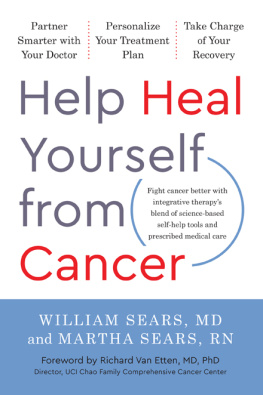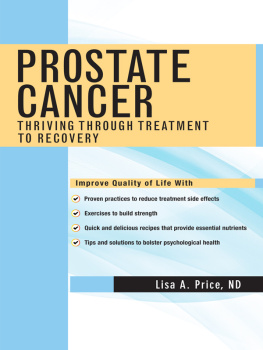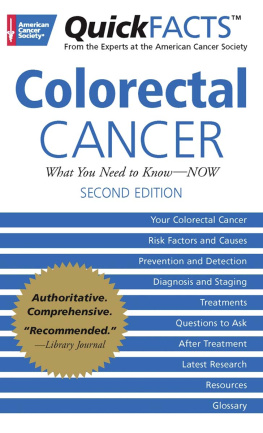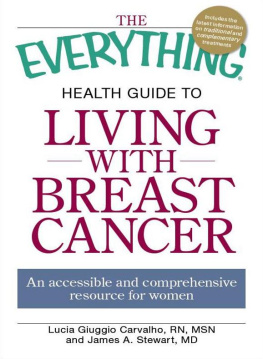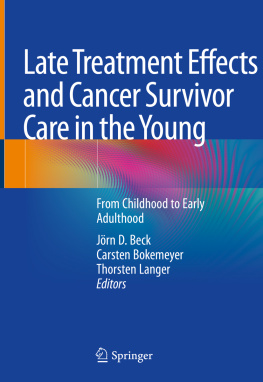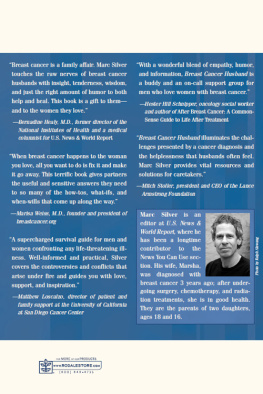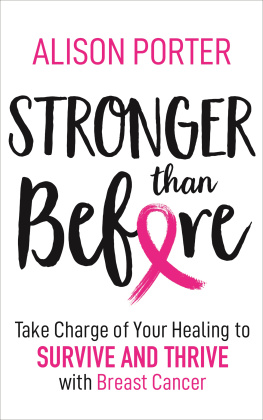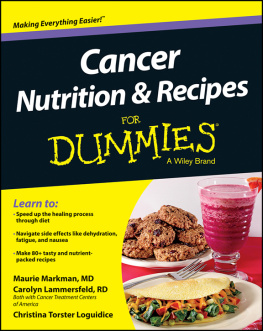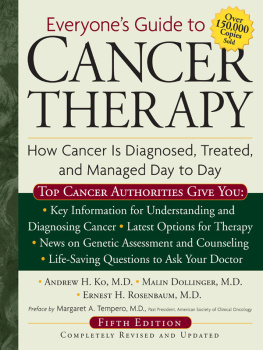B EFORE AND A FTER C ANCER T REATMENT
A
J OHNS
H OPKINS
P RESS
H EALTH B OOK
B EFORE AND A FTER C ANCER T REATMENT
Heal
Faster, Better, Stronger
Second Edition
Julie K. Silver, MD

Note to the reader: This book is not meant to substitute for medical care, and treatment should not be based solely on its contents. Instead, treatment must be developed in a dialogue between the individual and his or her physician. Our book has been written to help with that dialogue.
Drug dosage: The author and publisher have made reasonable efforts to determine that the selection of drugs discussed in this text conform to the practices of the general medical community. The medications described do not necessarily have specific approval by the U.S. Food and Drug Administration to treat the diseases for which they are recommended. In view of ongoing research, changes in governmental regulation, and the constant flow of information relating to drug therapy and drug reactions, the reader is urged to check the package insert of each drug for any change in indications and dosage and for warnings and precautions. This is particularly important when the recommended agent is a new or infrequently used drug.
In order to protect the privacy of patients whose stories are told in this book, the author has changed their names and identifying characteristics.
2006, 2015 Johns Hopkins University Press
All rights reserved. Published 2015. First edition published 2006 as
After Cancer Treatment: Heal Faster, Better, Stronger.
Printed in the United States of America on acid-free paper
2 4 6 8 9 7 5 3 1
Johns Hopkins University Press
2715 North Charles Street
Baltimore, Maryland 21218-4363
www.press.jhu.edu
Library of Congress Cataloging-in-Publication Data
Silver, J. K. (Julie K.), 1965
[After cancer treatment]
Before and after cancer treatment : heal faster, better, stronger / Julie K. Silver, MD Second edition.
pages cm
Revision of: After cancer treatment. 2006.
Includes bibliographical references and index.
ISBN 978-1-4214-1794-3 (hardcover : alk. paper) ISBN 978-1-4214-1777-6 (pbk. : alk. paper) ISBN (electronic) 978-1-4214-1778-3 (electronic) ISBN 1-4214-1794-4 (hardcover : alk. paper) ISBN 1-4214-1777-4 (pbk. : alk. paper) ISBN (electronic) 1-4214-1778-2 (electronic) 1. CancerPopular works. 2. CancerPsychological aspects. 3. CancerPatientsRehabilitation. 4. Self-care, Health. I. Title.
RC263.S489 2015
616.994dc23 2014049512
A catalog record for this book is available from the British Library.
Special discounts are available for bulk purchases of this book. For more information, please contact Special Sales at 410-516-6936 or .
Johns Hopkins University Press uses environmentally friendly book materials, including recycled text paper that is composed of at least 30 percent post-consumer waste, whenever possible.
A cancer diagnosis throws us into turmoil and for a time can control our lives. The purpose of this book is to help you take back some controlstep by step.
This book is dedicated to those who have had their lives shattered by cancer. Though it is not easy, we can pick up the pieces and strive to heal.
C ONTENTS
C HAPTER 1
Get Your Life Back on Track
C HAPTER 2
Understand Physical Healing
C HAPTER 3
Dare to Dream Again
C HAPTER 4
Prioritize What You Do and Pace Yourself
C HAPTER 5
Seek Help from Conventional Medicine
C HAPTER 6
Explore Eastern and Other Medical Systems
C HAPTER 7
Dance, Skip, and Walk: Exercise Your Way Back to Health
C HAPTER 8
Nourish Your Body
C HAPTER 9
Fight Fatigue
C HAPTER 10
Ease Your Pain
C HAPTER 11
Monitor Your Mood
C HAPTER 12
Tap into Your Spirituality
C HAPTER 13
Love and Be Loved
C HAPTER 14
Surmount Setbacks
C HAPTER 15
Look Whats on the Horizon
A CKNOWLEDGMENTS
Each time I have written a book, many people have helped in the publishing process. With this book, however, I received more than publishing assistance. My family, friends, colleagues, doctors, and other healthcare providers all facilitated my recovery and, in turn, my ability to write this book. They selflessly gave me their time, attention, and knowledge. It is impossible to overstate the value of loved ones during a cancer experience. My husband, children, mother, brother, and sister provided amazing support and nurturing. My in-laws and friends picked up the pieces of a life temporarily shattered. Neighbors tracked my treatment and provided carpooling, meals, and so much more. I am eternally grateful to them. My colleagues at work also sent meals and gifts for my children and stood by me during this difficult period. My childrens teachers and the mothers of some of their classmates watched over my children at school and helped them (and me) immensely. And of course I am indebted to the doctors, nurses, and other healthcare providers whose knowledge, skill, and empathy made my recovery possible.
At Johns Hopkins University Press, Jacqueline Wehmueller is a skillful, smart, and compassionate editor. Kathy Alexander, Hilary Jacqmin, Carrie Watterson, and Courtney Bond also worked with me on this book, and I am grateful for their expertise.
Finally, I want to thank all of the cancer survivors who have inspired me with their stories of healing and triumph.
B EFORE AND A FTER C ANCER T REATMENT
CHAPTER 1
G ET Y OUR L IFE B ACK ON T RACK
I was just diagnosed with cancer, what should I do now? This is a question that I am asked so often by colleagues, relatives, friends, and acquaintancespeople who are not my patients. There are some important next steps to take. This book is filled with practical advice that I hope will help you, and I want to get started right away. So, is a list of the key things to consider if youve recently been diagnosed with cancer.
Nearly every cancer diagnosis is the beginning of a personal journey that involves many complicated conversations with healthcare professionals and challenges for both the person who has the diagnosis as well as loved ones. Ironically, unlike with most other illnesses, people are often in the best physical health before they start treatment and then over time become increasingly ill from the therapies. Because of medical advances over the past hundred years or so, our understanding of how to cure many ailments has dramatically improved. Now when people go to the doctor, the prescribed treatments usually help without causing further injury. Even surgeries, after a relatively brief recovery period, generally relieve people of pain and other serious problems. Not so with cancer. People with cancer often dont know they have dangerous cells lurking in their bodies. A lump or bump, which might go unnoticed, may be the only sign. Yet the treatment is not something they can fail to recognize. The treatments for different kinds of cancers and even for the same kind can vary dramatically, but they are often exhausting and painful cocktails that may include surgery, chemotherapy, and radiation. Other treatments are also used, depending on the type of cancer and what it will likely respond to.
Table 1.1. What to Do after a New Cancer Diagnosis
Twelve Things You Can Do Right Now
1. Find doctors you trust and reach out to them and other members of your healthcare team for medical advice.
2. Consider getting a second opinion. This will either confirm that you are on the right path or will give you other treatment options to consider. Either way, another opinion often helps to avoid regrets later.
Next page

